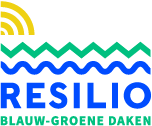FREQUENTLY ASKED QUESTIONS
QUESTIONS FOR RESIDENTS OF PARTICIPATING CORPORATION HOUSES
My roof is participating in the RESILIO project and I have a comment or question, who can I contact?
QUESTIONS FOR PRIVATE ROOF OWNERS
Information about the costs of construction will become available when the grant conditions are announced at the beginning of 2020. Keep an eye on the website of the Municipality of Amsterdam.
QUESTIONS ABOUT SMART BLUE-GREEN ROOFS
Excess rainwater is stored underneath the green layer of plants on the roof. This makes sure that the plants will always have enough water. The water can be discharged through a “smart valve”. This smart valve responds to weather change and opens and closes automatically at the right times. This is useful if, for example, a lot of rain falls. Look for more information on this page.
The blue-green roofs are linked to accurate weather forecasts to retain or discharge the rainwater. The valves on the roofs are controlled from a central point to open or close. This is regulated by Waternet, the water manager company of Amsterdam. The roofs are also connected to all kinds of sensors. For example, in the groundwater and the sewage system, so that we know when it is a good time to discharge the rainwater. By connecting the roofs with each other we can collect data: how much rainwater is collected in the various neighbourhoods, are there differences between them and how can we use that information? Look for more information on this page.
Blue-green roofs can absorb more rainwater than normal green roofs and so they can evaporate for longer during heat and drought. This keeps the houses and the neighbourhood cooler. Also, more variety of plants are able to grow on the roof, which increases biodiversity.
It is possible to combine a blue-green roof with solar panels. A blue-green roof has a cooling effect which means the solar panels produce higher energy yield.
QUESTIONS ABOUT THE RESILIO PROJECT
Housing corporations De Key, Stadgenoot and de Alliantie have provided 8.000 m2 of roof area that will be transformed in the neighbourhoods mentioned above. In 2020 there will be a subsidy for homeowners who want to construct a blue-green roof themselves. In this way another 2.000 m2 of blue-green roofs can be added.
After the project, the blue-green roofs will be maintained by the housing associations for a minimum of 5 years. The intention is that the blue-green roofs will be permanent and will also be realized on many more roofs in the city. In the RESILIO project we investigate what the best way is to succeed in this.
RESILIO is a collaboration between the Municipality of Amsterdam, Waternet, MetroPolder Company, Rooftop Revolution, HvA, VU, Stadgenoot, de Alliantie, De Key and Consolidated.
The project is co-financed by the European Regional Development Fund through the Urban Innovative Actions Initiative. The UIA program grants subsidies for innovative pilot projects on different themes. The consortium has received a subsidy of € 4.8 million as an innovative project in the field of climate adaptation. 80 percent of the costs are paid from the UIA subsidy. Each partner provides the remaining 20 percent of the investment.
The project started on 1st of November 2018 and ends on the 31st of October 2021.
RESILIO is an acronym for ‘Resilience nEtwork of Smart Innovative cLImate-adapative rOoftops’. The core of this complicated name is “resilience”. And that’s what it’s all about: smart blue-green roofs that form a buffer for intense rainfall or prolonged drought.
Currently, a study is being done on which roofs of the housing corporations that participate in the RESILIO project a combination of yellow (solar panels) and blue-green can be carried out.
